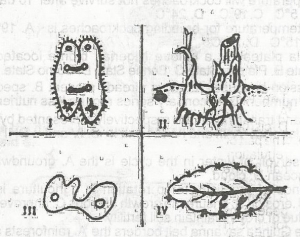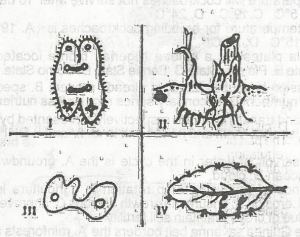Year :
2006
Title :
Biology
Exam :
JAMB Exam
Paper 1 | Objectives
31 - 40 of 50 Questions
| # | Question | Ans |
|---|---|---|
| 31. |
 The organ through which the embryo receives food, water and oxygen is labelled A. III B. IV C. II D. I |
C |
| 32. |
Mammals are capable of producing hypertonic urine mainly because of re-absorption in the A. Bowmans capsule B. Urethra C. Ureter D. Loop of henle |
D |
| 33. |
 Using the diagram, sexual reproduction is illustrated in A. ii B. i C. iii D. iv |
B |
| 34. |
 Using the diagram, A plant that exhibits the type of reproduction shown in IV is A. cola B. ginger C. bryophyllum D. sugar cane |
C |
| 35. |
 Using the diagram, the part labelled IV is for A. excretion B. nourishment C. protection D. respiration |
C |
| 36. |
 In the diagram, the organ through which the embryo receives food, water and oxygen is labelled A. iii B. iv C. ii D. i |
C |
| 37. |
 The diagram represents the structure of A. proteins B. chromosones C. RNA D. DNA |
D |
| 38. |
 In the diagram, the part labelled I represents the A. base pairs B. ribose sugar C. phosphate linkage D. deoxyri-bose sugar |
A |
| 39. |
 In the diagram, the change in the length of the neck of the giraffes shown was brought about by A. geographical isolation B. predation C. symbiosis D. natural selection |
D |
| 40. |
 In the diagram, the variation illustration is A. discontinuous B. morphological C. physiological D. biochemical |
B |
| 31. |
 The organ through which the embryo receives food, water and oxygen is labelled A. III B. IV C. II D. I |
C |
| 32. |
Mammals are capable of producing hypertonic urine mainly because of re-absorption in the A. Bowmans capsule B. Urethra C. Ureter D. Loop of henle |
D |
| 33. |
 Using the diagram, sexual reproduction is illustrated in A. ii B. i C. iii D. iv |
B |
| 34. |
 Using the diagram, A plant that exhibits the type of reproduction shown in IV is A. cola B. ginger C. bryophyllum D. sugar cane |
C |
| 35. |
 Using the diagram, the part labelled IV is for A. excretion B. nourishment C. protection D. respiration |
C |
| 36. |
 In the diagram, the organ through which the embryo receives food, water and oxygen is labelled A. iii B. iv C. ii D. i |
C |
| 37. |
 The diagram represents the structure of A. proteins B. chromosones C. RNA D. DNA |
D |
| 38. |
 In the diagram, the part labelled I represents the A. base pairs B. ribose sugar C. phosphate linkage D. deoxyri-bose sugar |
A |
| 39. |
 In the diagram, the change in the length of the neck of the giraffes shown was brought about by A. geographical isolation B. predation C. symbiosis D. natural selection |
D |
| 40. |
 In the diagram, the variation illustration is A. discontinuous B. morphological C. physiological D. biochemical |
B |